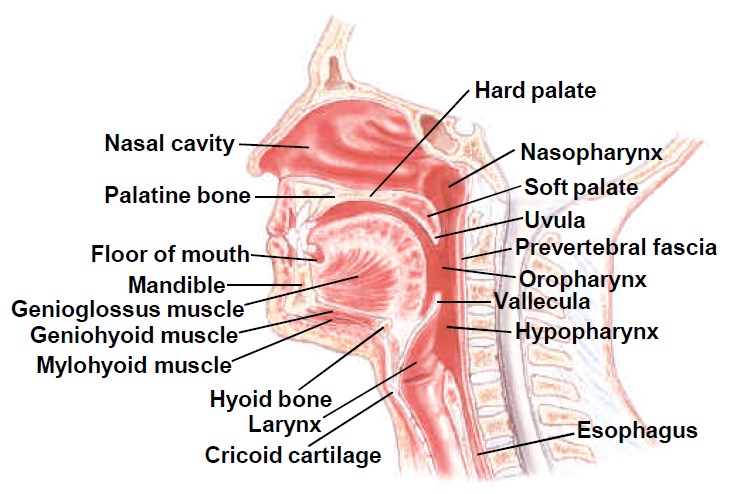
F or oropharynx and nasopharynx cancers, it is sometimes possible to limit the dose received by the larynx according to the extent of the primary lesion. Thus, if the tumour constraints permit, the maximum dose to the larynx must be less than 63 to 66 Gy. To reduce the risk of laryngeal edema, it is recommended if possible to limit the mean non-involved larynx dose to 40 to 45 Gy [to prevent dysphonia or significant damage to vocal cords/folds].”T he question in this post's title has arisen several times each year over the 5 years I've been writing this blog. A relatively small percentage of the approximately 52,000 persons per year who receive a diagnosis of some form of cancer of the head and neck (U.S. SEER statistics; AHRQ HCUPnet statistics for procedures HCPCS L30318, G0251, G0339, G0340; CPT-4 77373, 77401-77435, etc.; ICD-9 92.3x) and the thousands of patients (U.S.) who receive radiation to the neck as part of a treatment regimen for a head-and-neck cancer are singers—either avid amateurs or professionals. However, the rate of inquiry by (or on behalf of) singers for whom this situation does happen is evidently not by any means ‘rare’. There have been 6 such search-strings that I have noticed in the CMT traffic logs in the past 3 weeks alone.
— C. Debelleix and co-workers, Centre Hospitalier Dax-Côte d'Argent, France.
S o this post is meant to provide you with links to recent medical literature that you can show to your otolaryngologist/oncologist and discuss. In that regard, the typical radiation oncologist tends not to be expert in medical management of musicians; conversely, specialists in medical problems of musicians tend not to have a great deal of experience with head-and-neck cancers for which radiation therapy is routinely used. This is compounded by the fact that the situation of singers undergoing radiation to the neck is just uncommon enough that there are not many clinical trials or specific studies conducted in that population. The published studies that have some relevancy to the question are not easy for your physician to locate online or in the library either—which is why I believe providing these links will be helpful.
A majority of the published work on this topic has to do with ‘quality-of-life’ (QoL) measurement in cancer patients treated with radiation to the neck, where one of the QoL measurements is ease of vocalization and the frequency and severity of pain or hoarseness or other forms of dysphonia or vocal abnormalities.
F or each patient, the specific cancer type and the extent of the cancer’s spread and other factors contribute to the decision-making as to whether ‘larynx-sparing’ reduced-dose, stereotactic, imagery-guided radiation therapy is a sensible approach or not. But in those cases where it is deemed to be a reasonable approach, there are specific guidelines for planning and conducting such radiotherapy.
O f course, there is no guarantee that returning to singing will be achievable, or that vocal quality or agility or range or endurance will be the same as they were prior to treatment. But to get the best chance for those outcomes, the info in the lit below should be part of your decision-making with your doctors.
I f you’re one of those who’ve been hitting the web and this blog looking for info on larynx-preserving radiotherapy and prognosis with regard to return to post-treatment singing, maybe the links below will be useful for you and your doc!
- Carrara-deAngelis E, et al. Voice and swallowing in patients enrolled in a larynx preservation trial. Arch Otolaryngol Head Neck Surg 2003;129:733-8.
- Debelleix C, et al. Normal tissue tolerance to external beam radiation therapy: Larynx and pharynx. Canc Radiother 2010;14:301-6.
- Di Nicola L, et al. The impact of conventional or hypofractionated radiotherapy on voice quality and oncological outcome in patients with early glottic cancer. Oncol Rep 2010;24:1383-8.
- Dornfeld K, et al. Radiation doses to structures within and adjacent to the larynx are correlated with long-term diet– and speech–related quality of life. Int J Rad Oncol Biol Phys 2007;68:750–7.
- Nguyen N, et al. Effectiveness of image-guided radiotherapy for laryngeal sparing in head and neck cancer. Oral Oncol 2010;46:283-6.
- Rancati T, et al. Radiation dose-volume effects in the larynx and pharynx. Int J Rad Oncol Biol Phys 2010;76:S64-9.
- Saltman B, et al. In vivo and in vitro models of ionizing radiation to the vocal folds. Head & Neck 2010;32:572-7.
- Satalof R, Hawkshaw M. Common medical diagnoses and treatments for patients' voice. Perf Arts Med 2010;3:133-40.
- Webster G, et al. Evaluation of larynx-sparing techniques with IMRT when treating the head and neck. Int J Rad Oncol Biol Phys 2008;72:617-22.
- NCI overview on head-and-neck cancers
- NCI SEER data
- NCI SEER coding
- American Society for Radiation Oncology website
No comments:
Post a Comment